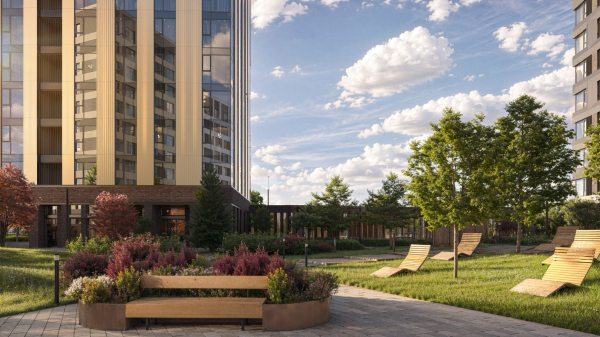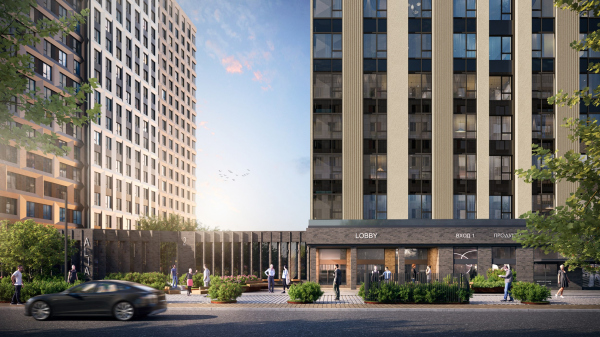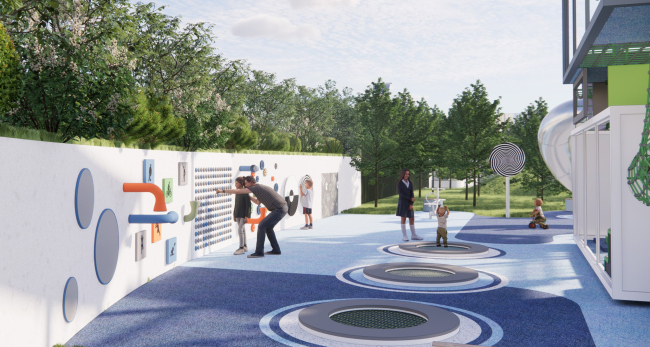|
Published on Archi.ru (https://archi.ru) |
|
| 18.11.2024 | |
|
Flexibility and Integration |
|
|
Julia Tarabarina |
|
| Studio: | |
| APEX Project Bureau | |
|
Not long ago, we covered the project for the fourth phase of the ÁLIA residential complex, designed by APEX. Now, we’ve been shown different fence concepts they developed to enclose the complex’s private courtyards, incorporating a variety of public functions. We believe that the sheer fact that the complex’s architects were involved in such a detail as fencing speaks volumes. The main feature of these enclosures is that public spaces are planned to integrate not only from within but also from outside the fences. This creates “transitional spaces” that are open to the city yet secure, aided by integrated monitoring and video surveillance security systems.  , APEX Project Bureau In our designs, we generally aim to avoid traditional fencing, instead enclosing the site’s perimeter with the building volume itself, single-story commercial structures, or elements like pergolas, small architectural forms, and landscaping with amphitheater-style terraces. The use of traditional fences is minimized and reserved for practical needs, such as the gate for fire lanes. Even in such cases, the fencing is created with vertical slats, without horizontal rails or a top handrail. Several options were presented. The first is a traditional yet transparent, grid-like fence, allowing visibility and leaving space in front for a favorite urban pastime enjoyed by nearly all ages – large swings. Fencing options built into the Alia Residential Complex Phase 4 landscaping projectCopyright: © APEX / provided by AsterusAnother approach transforms the fence, or, should we say, “the barrier” into a public area, with seating steps and even café tables. This type of boundary isn’t perceived as a fence; it becomes part of the park, courtyard, or even the entire urban landscape, especially if combined with segments of green hedges.  Fencing options built into the Alia Residential Complex Phase 4 landscaping projectCopyright: © APEX / provided by Asterus Fencing options built into the Alia Residential Complex Phase 4 landscaping projectCopyright: © APEX / provided by AsterusThe walls can also be adapted for use as part of a sports area. Fencing options built into the Alia Residential Complex Phase 4 landscaping projectCopyright: © APEX / provided by AsterusLastly, there are designs for low-height, flexible barriers that serve to zone courtyard spaces. Fencing options built into the Alia Residential Complex Phase 4 landscaping projectCopyright: © APEX / provided by AsterusNotably, the small architectural forms and fences in the ÁLIA residential complex neighborhoods are also designed by the same architects who developed the residential buildings. For the fourth phase, this is the APEX team, while for the third phase, it’s the CONTINUUM bureau. In their project, brick enclosures continue the color and texture of the residential walls, combining large ribbed sections with fine mesh inserts. This is an architectural alternative to a solid wall – porous yet linked to the façade’s overall aesthetic.  Courtyard space of the 3rd stage of Alia Residential ComplexCopyright: © APEX / provided by Asterus Courtyard space of the 3rd stage of Alia Residential ComplexCopyright: © APEX / provided by AsterusIt’s clear that fences are barriers have always been a topic of ongoing exploration, one that grapples with one of today’s most challenging paradoxes: the need for spaces to be both public and private, shared and individual, open and secure. This is a complex paradox, and both sides – those in favor of complete openness and those for total enclosure – have their valid points. Hence, the search continues for an optimal fence design, which seems to be expanding with new concepts and variations. Key trends in recent years include transparent enclosures made of glass or perforated panels, green walls, and automated security systems featuring smart technology that, according to a press release from Asterus, the developer behind the ÁLIA residential complex, “ensures a high level of safety without overloading the landscape”. It remains to be seen which trend will prevail: traditional green hedges or cutting-edge security technology. But perhaps what resonates even more with us is another aspect of this approach – the fact that the fences and small architectural forms are designed by the same architects who designed the residential buildings. This consistency is both logical and makes perfect sense. |
|


